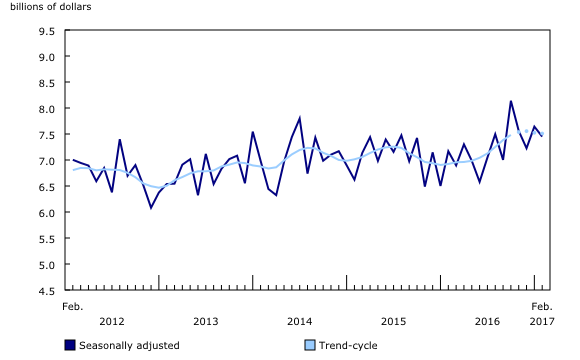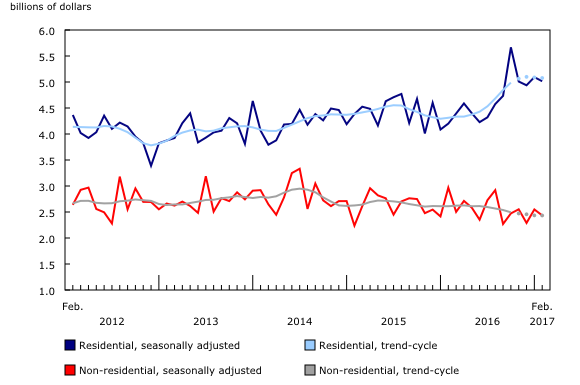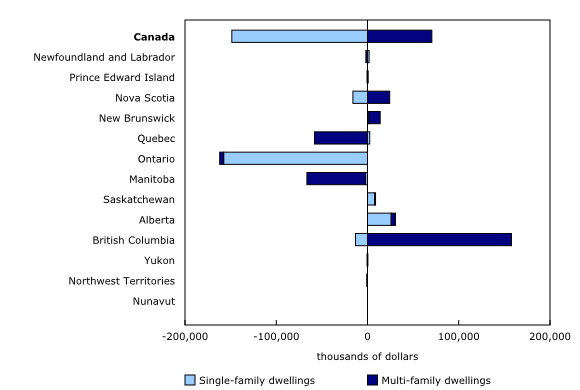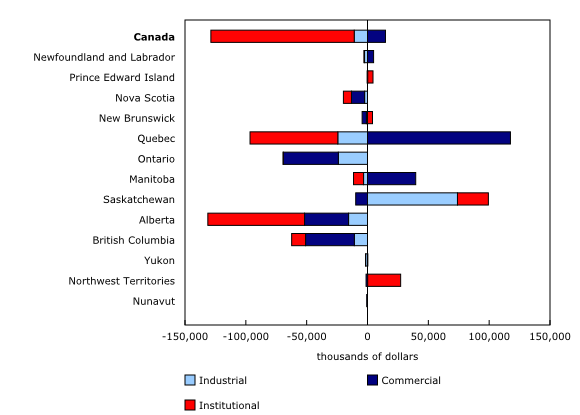Building permits, February 2017
Archived Content
Information identified as archived is provided for reference, research or recordkeeping purposes. It is not subject to the Government of Canada Web Standards and has not been altered or updated since it was archived. Please "contact us" to request a format other than those available.
Released: 2017-04-06
$7.5 billion
February 2017
-2.5% 
(monthly change)
$45.6 million
February 2017
4.7% 
(monthly change)
$19.6 million
February 2017
29.3% 
(monthly change)
$136.5 million
February 2017
-7.8% 
(monthly change)
$112.9 million
February 2017
13.7% 
(monthly change)
$1,201.2 million
February 2017
-2.8% 
(monthly change)
$3,026.8 million
February 2017
-7.1% 
(monthly change)
$264.1 million
February 2017
-12.6% 
(monthly change)
$246.7 million
February 2017
66.4% 
(monthly change)
$1,120.7 million
February 2017
-8.2% 
(monthly change)
$1,243.9 million
February 2017
7.1% 
(monthly change)
$2.9 million
February 2017
-31.0% 
(monthly change)
$29.1 million
February 2017
707.6% 
(monthly change)
$0.0 million
February 2017
-98.5% 
(monthly change)
Canadian municipalities issued $7.5 billion worth of building permits in February, down 2.5% from January. Ontario and Alberta led the five provinces that reported declines in February. The national decrease was mainly the result of lower construction intentions for single-family dwellings and institutional structures.
Residential sector: Decrease in single-family dwellings moderated by growth in multi-family buildings
The value of residential building permits issued by Canadian municipalities fell 1.5% from January to $5.0 billion in February, but remained just above the $5.0 billion mark for a second consecutive month. The decline in single-family construction intentions was moderated by an increase in the multi-family component. Four provinces posted decreases in the residential sector in February, led by Ontario.
Construction intentions for single-family dwellings declined 5.4% to $2.6 billion in February. Ontario registered the greatest decrease in this component, more than offsetting the six provinces that reported gains.
Conversely, multi-family construction intentions increased 3.0% to $2.4 billion in February, a second consecutive monthly gain. The increase was mainly attributable to apartment buildings in both British Columbia and Alberta.
In February, Canadian municipalities approved the construction of 19,903 new dwellings (+2.9%), consisting of 13,445 multi-family units (+9.3%) and 6,458 single units (-8.3%).
Non-residential sector: Declines in institutional and industrial components
Municipalities issued $2.4 billion worth of building permits for non-residential structures in February, down 4.5% from January. Five provinces registered decreases, led by Alberta and followed by Ontario and British Columbia. Nationally, the institutional component contributed the most to the decline.
The institutional component decreased 16.2% to $609 million in February, mainly due to lower construction intentions for government buildings and elementary schools. Alberta and Quebec posted the largest declines among the provinces and territories. A hospital revitalization project in the Northwest Territories moderated the drop in the national value of institutional building permits in February.
In February, the value of building permits issued for industrial structures fell 2.7% to $395 million, following a 9.9% increase in the previous month. Higher construction intentions for utility buildings in Saskatchewan and Ontario could not offset the widespread decreases reported across several types of industrial buildings in multiple provinces.
The commercial component rose 1.0% to $1.4 billion in February, marking a second consecutive monthly increase. The gain was mainly attributable to higher construction intentions for office buildings in Quebec and Manitoba.
Provinces: Ontario posts declines in every component, while British Columbia registers gains on strength of multi-family dwellings
The total value of building permits decreased in five provinces in February, led by Ontario and Alberta. Saskatchewan and British Columbia reported the largest increases.
Ontario posted a second consecutive monthly decline in the value of building permits in February. Every building component registered decreases, particularly single-family dwellings.
In Alberta, following growth in every building component in January, the decrease in the value of building permits in February originated mostly in the non-residential sector. The decline was led by the institutional component. Conversely, residential construction intentions in Alberta increased for a second consecutive month in February, on the strength of apartment buildings and single-family dwellings.
Saskatchewan reported an increase in every building component in February except commercial structures. Utility buildings, notably a new natural gas power generation facility, contributed the most to the overall advance. For a second month in a row, Saskatchewan reported gains in both single-family and multi-family buildings in February.
In British Columbia, multi-family dwellings led the increase in building permit values in February, more than offsetting declines registered in every other building component. This marks a second consecutive monthly increase in multi-family construction intentions for British Columbia.
Census metropolitan areas: Notable decrease in Edmonton, while Vancouver posts the largest increase
In February, the value of building permits declined in 22 out of the 36 census metropolitan areas (CMAs). Edmonton registered the biggest decline, followed distantly by Montréal, Toronto and Hamilton.
The decrease in the value of building permits in Edmonton was largely the result of institutional structures, led by government buildings. This followed a strong month in January when Edmonton reported its second-highest value on record in institutional building permits.
Lower construction intentions for institutional structures and multi-family buildings were mainly responsible for the declines in both Montréal and Hamilton in February. In Toronto, the decrease was mostly attributable to multi-family dwellings.
In contrast, Vancouver reported the highest growth in the value of building permits among the CMAs in February. Increased construction intentions for both rental apartments and apartment-condominiums were mainly responsible for the advance. The multi-family dwelling component rose for a second consecutive month in Vancouver in February.
Note to readers
Unless otherwise stated, this release presents seasonally adjusted data, which facilitate comparisons by removing the effects of seasonal variations. For information on seasonal adjustment, see Seasonally adjusted data – Frequently asked questions.
The Building Permits Survey covers over 2,400 municipalities, representing 95% of the Canadian population. The communities representing the other 5% of the population are very small and their levels of building activity have little impact on the total for the entire population.
Building permits data are used as a leading indicator of activity in the construction industry.
The value of planned construction activities presented in this release excludes engineering projects (such as waterworks, sewers or culverts) and land.
For the purposes of this release, the census metropolitan area of Ottawa–Gatineau (Ontario/Quebec) is divided into two areas: the Gatineau part and the Ottawa part.
Unless otherwise specified, the highlights refer to seasonally adjusted current dollars and are ranked in terms of dollar change rather than percentage change.
Revision
Data for the current reference month are subject to revision based on late responses. Data for the previous month have been revised.
Trend-cycle estimates have been added to the charts as a complement to the seasonally adjusted series. Both the seasonally adjusted and the trend-cycle estimates are subject to revision as additional observations become available. These revisions could be large and even lead to a reversal of movement, especially at the end of the series. The higher variability associated with the trend-cycle estimates is indicated with a dotted line on the chart.
For information on trend-cycle data, see the StatCan Blog and Trend-cycle estimates – Frequently asked questions.
Next release
Data for March on building permits will be released on May 9.
Products
The February issue of Building Permits (64-001-X) will soon be available.
Contact information
For more information, or to enquire about the concepts, methods or data quality of this release, contact us (toll-free 1-800-263-1136; 514-283-8300; STATCAN.infostats-infostats.STATCAN@canada.ca) or Media Relations (613-951-4636; STATCAN.mediahotline-ligneinfomedias.STATCAN@canada.ca).
- Date modified:





